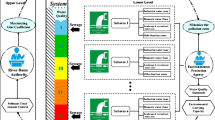Abstract
Waste load allocation is always regarded as another efficient approach comparing with the technology-based approach to improve the water quality. This paper proposes a bi-level multi-objective optimization model for optimally allocating the waste load of a river basin incorporating some concerns (i) the allocation equity from the regional authority, (ii) maximal benefits from the subareas along the river, and (iii) the Stackelberg-Nash-Cournot equilibrium strategy between the upper and lower decision makers. Especially, a novel Gini coefficient for measuring the load allocation equity is defined by considering the economic level and waste water quantity. The applicability and effectiveness of the proposed model is demonstrated through a practical case based on the Tuojiang River, which is a typical basin with diversified industrial waste discharges in western China. Some operational suggestions are developed to assist the decision makers’ cope with deteriorating water systems.








Similar content being viewed by others
References
Allam A, Tawfik A, Yoshimura C et al (2016) Multi-objective models of waste load allocation toward a sustainable reuse of drainage water in irrigation. Environ Sci Pollut Res:1–12
Carpenter SR et al (1998) Nonpoint pollution of surface waters with phosphorus and nitrogen. Ecol Appl 8 (3):559–568
Chamnanlor C, Sethanan K, Chien CF, Gen M (2014) Re-entrant flow shop scheduling problem with time windows using hybrid genetic algorithm based on auto-tuning strategy. Int J Prod Res 52(9):2612–2629
Cook C, Bakker K (2012) Water security: debating an emerging paradigm. Glob Environ Chang 22(1):94–102
Enfors EI, Gordon LJ (2008) Dealing with drought: the challenge of using water system technologies to break dryland poverty traps. Glob Environ Chang 18(4):607–616
Feizi Ashtiani E, Niksokhan MH, Ardestani M (2015) Multi-objective waste load allocation in river system by MOPSO algorithm. Int J Environ Res 9(1):69–76
Flörke A, Märker M (2007) Future long-term changes in global water resources driven by socio-economic and climatic changes. Hydrol Sci J 52(2):247–275
Freni G, Mannina G, Viviani G (2008) Uncertainty in urban stormwater quality modelling: the effect of acceptability threshold in the GLUE methodology. Water Res 42(8):2061–2072
Gong L, Jin C (2009) Fuzzy comprehensive evaluation for carrying capacity of regional water resources. Water Resour Manag 23(12):2505–2513
Hu XH, Li YP, Huang GH et al (2016) A Bayesian-based two-stage inexact optimization method for supporting stream water quality management in the three Gorges reservoir region. Environ Sci Pollut Res:1–19
Jiao A, Li Z, Wang L, Xia M (2013) Optimization for municipal solid waste treatment based on energy consumption and contaminant emission. Environ Sci Pollut Res 20:6232–6241
Lei K, Zhou G, Guo F et al (2015) Simulation–optimization method based on rationality evaluation for waste load allocation in Daliao river. Environ Earth Sci 73:5193–5209
Mahjouri N, Abbasi MR (2015) Waste load allocation in rivers under uncertainty: application of social choice procedures. Environ Monit Assess 187(2):1–15
Marler RT, Arora JS (2004) Survey of multi-objective optimization methods for engineering. Struct Multidiscip Optim 26(6):369– 395
Marler RT, Arora JS (2010) The weighted sum method for multi-objective optimization: new insights. Struct Multidiscip Optim 41(6):853–862
Milman A, Short A (2008) Incorporating resilience into sustainability indicators: an example for the urban water sector. Glob Environ Chang 18(4):758–767
Mujumdar PP, Subbarao Vemula VR (2004) Fuzzy waste load allocation model: simulation-optimization approach. J Comput Civil Eng 18(2):120–131
Neungmatcha W, Sethanan K, Gen M, Theerakulpisut S (2013) Adaptive genetic algorithm for solving sugarcane loading stations with multi-facility services problem. Comput Electron Agr 98:85– 99
O’Connor DJ, Dobbins WE (1958) Mechanism of reaeration in natural streams. T Am Soc Civ Eng 123(1):641–666
Qin XS, Huang GH, Chen B, Zhang BY (2009) An interval-parameter waste-load-allocation model for river water quality management under uncertainty. Environ Manage 43(6):999–1012
Sadras V, Bongiovanni R (2004) Use of Lorenz curves and Gini coefficients to assess yield inequality within paddocks. Field Crop Res 90(2):303–310
Taylor RG et al (2013) Ground water and climate change. Nat Clim Chang 3:322–329
Thomann RV, Mueller JA (1987) Principles of surface water quality modeling and control. Harper & Row Publishers
World Resources Institute World Resources (2000–2001) Available at http://www.wri.org/wr2000
Xu JP, Tu Y, Zeng ZQ (2012) Bilevel optimization of regional water resources allocation problem under fuzzy random environment. J Water Res Pl-ASCE 139(3):246–264
Zhang W, Wang H, Hang F, et al (2014a) Modeling urban growth by the use of a multiobjective optimization approach: environmental and economic issues for the Yangtze watershed, China. Environ Sci Pollut Res 21:13027–13042
Zhang JL, Li YP, Huang GH (2014b) A robust simulation–optimization modeling system for effluent trading - a case study of nonpoint source pollution control. Environ Sci Pollut Res 21:5036–5053
Zaidi AZ, deMonsabert SM (2015) Economic total maximum daily load for watershed-based pollutant trading. Environ Sci Pollut Res 22:6308–6324
Acknowledgments
This research was supported by the Key Program of NSFC (Grant No. 70831005), the National Natural Science Foundation of China (Grant No. 71301109), the Western and Frontier Region Project of Humanity and Social Sciences Research, Ministry of Education of China (Grant No. 13XJC630018), the Research Foundation of Ministry of Education for the Doctoral Program of Higher Education of China (Grant No. 20130181110063), and the Initial Funding for Young Teachers of Sichuan University (Grant No. 2013SCU11014).
Author information
Authors and Affiliations
Corresponding author
Additional information
Responsible Editor: Marcus Schulz
Rights and permissions
About this article
Cite this article
Yao, L., Xu, J., Zhang, M. et al. Waste load equilibrium allocation: a soft path for coping with deteriorating water systems. Environ Sci Pollut Res 23, 14968–14988 (2016). https://doi.org/10.1007/s11356-016-6593-5
Received:
Accepted:
Published:
Issue Date:
DOI: https://doi.org/10.1007/s11356-016-6593-5




